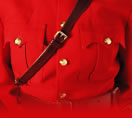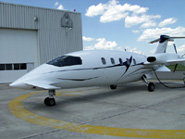| Français | Contact Us | Help | Search | Canada Site | ||||
| Home | A-Z Index | Scams/Fraud | Detachments | Publications | ||||



 |
|
| Home | |
| About the RCMP | |
| Organization | |
| RCMP Regions / Divisions | |
| Executive | |
| History | |
| Reports and Publications | |
| Musical Ride | |
| Best Practices | |
| Forms | |
| Priorities | |
| Programs and Services | |
| Newsroom | |
| Careers / Recruiting | |
RCMP Fact Sheets |
|
Air Services
 |
| QUICK FACTS
The RCMP is one of the largest fleet operators in Canada. In 2002-2003, Air Services personnel flew over 27,000,000 passenger miles, and logged more than 21,000 flying hours. The RCMP maintains 18 Air Sections and currently employs 126 people throughout the country, including 72 pilots and 43 aircraft maintenance engineers. Air Services Fleet includes: • 3 Cessna Caravans • 2 Twin Otters • 4 Bell 206 Helicopters • 4 Eurocopter AS 350B3s • 13 Pilatus PC-12s • 1 Piaggo Avanti P180 • 6 Cessnas |
Overview
Air Services is one of nine branches of the RCMP’s Technical Operations Directorate. The first priority of Air Services is to provide air support and assistance to operational personnel.
This includes northern and regional patrols; transporting personnel, prisoners and supplies; and carrying out searches.
An Officer oversees the entire Air Services operation from HQ Ottawa. The corporate structure of Air Services includes a Chief Pilot, Training Officer and Safety Officer.
The Director of Maintenance is located in Ottawa and is in charge of all aircraft maintenance in Air Services. He is assisted by a Quality Assurance manager, Regional managers East/West and an Avionics manager.
To ensure it has an efficient, cost effective and safe fleet of aircraft to support police operations, RCMP Air Services has adopted a fleet modernization or evergreen plan.
Cost, opportunity, service records, age and technology updates are key factors in the evergreen plan. Typically, each aircraft is replaced after seven years of use or approximately 7,000 flight hours.
History
RCMP Air Services got its start in April 1937, with four twin-engine bi-planes and eight regular member pilots. The planes, de Havilland Dragonflies with blue fuselages and yellow wings, were equipped with two-way radios and had a maximum range of more than 950 kilometres.
The new air section was temporarily housed in Downsview, Ontario. In July 1937, the Aviation Section moved to Moncton, New Brunswick. In 1939, the Dragonflies and their pilots were transferred to the RCAF for the duration of World War II, which left the Force with only one aircraft, a Norseman.
In 1946, more aircraft were acquired by the RCMP including an ex-RCAF Grumman Goose. The first helicopter – a Bell 212 – was added to the fleet in 1971.
Today, RCMP Air Services has over 30 operational aircraft, and employs pilots, aircraft maintenance engineers, flight coordinators as well as purchasers, quality assurance and support personnel.
Basic Requirements
The flexibility in using a coordinated pool group of professional and well-trained pilots and technicians minimizes the effects of vacancies and produces an economic air support operation.
For fixed wing pilots - a commercial pilots licence with a valid instrument rating and a minimum of 3,000 hours flight experience including turbine and pressurized experience is required.
For rotary wing pilots - a commercial pilots licence and a minimum of 3,000 hours flight experience, preferably including time on a Bell 206 and/or AS 350B3 helicopters is required.
Aircraft Maintenance Engineers and Avionics Engineers must meet the technical qualifications of the position.
| Content created: 2004-06-14 Content revised: 2004-06-14 |
Return to Top | Important Notices |